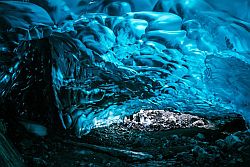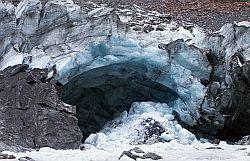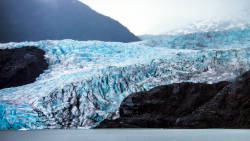Glacier Caves
Glacial Caves
Glacier Caves are formed in (water-)ice by melting. It is the result of a phase change of water.




First, a typical error: most people call glacier caves wrongly ice cave. Ice caves contain ice, the cave itself formed inside rock but is cold and dripping water forms icicles and layers of ice. Glacier caves form inside glaciers. We will list them on showcaves.com as glacier caves, but many of them are called ice cave on brochures or are even named Ice Cave. So be careful when the names are mixed up!
Caves inside ice are only possible if the ice deposit is big enough and does not immediately melt in spring. This kind of ice is called glacier, and is found all over the world. Huge glaciers cover the North and South Pole. Other glaciers cover mountains, e.g. in Greenland, Iceland, Norway, New Zealand, the Alps, and Alaska.
To create a cave inside a glacier, all we need is a little bit of warmth. Most glaciers are continually fed by snow in winter and loose ice as melting water in summer. The ice melts on the surface, and if there are cracks in the ice, the melting water flows through those cracks and down the glacier. As it is a little warmer than the ice, it also melts a little bit of ice where it flows, and so the water soon cuts a gorge into the glacier. As the ice itself flows slowly, the gorge closes some time after the water stops to flow. Only constantly flowing water keeps the passageway clear. But as it flows on the bottom of the gorge, the upper part of the gorge closes, and the gorge becomes a cave.
Most glacier caves survive only one season. But in some cases, there is a reason why the cave formed at this special location, and if this reason persists, the cave will be formed at the same place next year. In general, only glacier caves which form every year are named. Be aware that you will see a different cave each year.
A special thing are some glacier caves of Iceland. This island has many volcanic regions, so it is rather common that volcanoes or warm springs are located below glaciers. This volcanic warmth melts ice at the bottom of the glacier, thus producing a cavern inside. If the water has a way to flow out, it is air filled, if not it is water filled. There are so many glacier caves in Iceland that they even classify them by the color of the ice. This classification is not scientific, but as it is commonly used, we list it here, so you know what is meant by those terms.
- Crystal Ice Caves: clear ice lets sunlight into the cave, if it is not too thick, but it is filtered and only the blueish colors reach the cave creating an eerie turquoise glow.
- Blue Ice Caves: that’s actually the same as a Crystal Ice Cave, but the cave is deeper in the ice and the colour becomes a darker and intensive blue.
- Black Ice Cave: the black colour is caused by volcanic ash which is falling on the snow while the ice is formed, and it forms only where frequent eruptions cause frequent ash falls.
- Patterned Ice Caves: caves with weird and dramatic patterns on the ice. Ash falls caused layers of different colour, movement of the glacier deformed it, and when the water cuts through the layering, it forms fantastic patterns.
- Examples
 Big Four Ice Caves, U.S.A.
Big Four Ice Caves, U.S.A. Byron Glacier Ice Caves, U.S.A.
Byron Glacier Ice Caves, U.S.A. Eiskapelle, Germany
Eiskapelle, Germany Katla Ice Cave, Iceland
Katla Ice Cave, Iceland Kverkfjöll, Iceland
Kverkfjöll, Iceland Longyearbreen Grotte, Norway
Longyearbreen Grotte, Norway Mendenhall Ice Caves, U.S.A.
Mendenhall Ice Caves, U.S.A. Nigardsbreen Ice Cave, Norway
Nigardsbreen Ice Cave, Norway
- See also
 Search DuckDuckGo for "Glacier+Cave"
Search DuckDuckGo for "Glacier+Cave" Glacier cave (visited: 05-MAY-2019)
Glacier cave (visited: 05-MAY-2019) My glacier cave discoveries, TED (visited: 05-MAY-2019)
My glacier cave discoveries, TED (visited: 05-MAY-2019) Glacier Features: Glacier Caves (visited: 05-MAY-2019)
Glacier Features: Glacier Caves (visited: 05-MAY-2019) Glacier Cave Landforms (visited: 05-MAY-2019)
Glacier Cave Landforms (visited: 05-MAY-2019) Glacier caves by Dave Bunnell (visited: 05-MAY-2019)
Glacier caves by Dave Bunnell (visited: 05-MAY-2019) Ice Caves in Iceland, All about ice caves and glacier caves in Iceland (visited: 05-MAY-2019)
Ice Caves in Iceland, All about ice caves and glacier caves in Iceland (visited: 05-MAY-2019) What Is The Difference Between Ice Caves and Glacier Caves? (visited: 05-MAY-2019)
What Is The Difference Between Ice Caves and Glacier Caves? (visited: 05-MAY-2019) A Comprehensive Guide to Ice Caves in Iceland (visited: 26-JUL-2020)
A Comprehensive Guide to Ice Caves in Iceland (visited: 26-JUL-2020) 8 Types of Ice Caves in Iceland (visited: 26-JUL-2020)
8 Types of Ice Caves in Iceland (visited: 26-JUL-2020)

 Index
Index Topics
Topics Hierarchical
Hierarchical Countries
Countries Maps
Maps